Schiit Audio JIL A/D converter
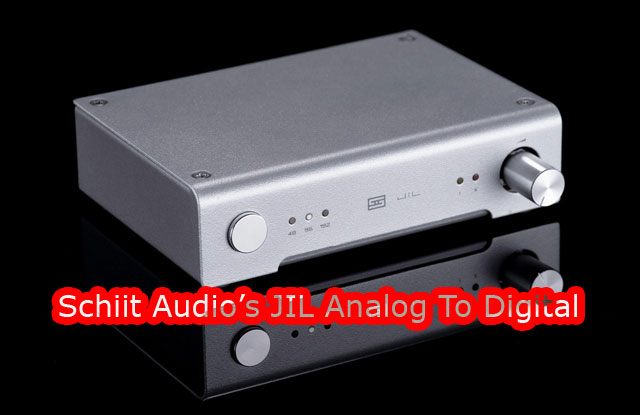
 I’ve always had some means of a recording device in my life. Since the age of fourteen and a small Akai reel to reel. Later on, I used a Revox A77 Half Track as my primary source for nearly two decades. At the dawn of high resolution downloading, I bought an MSB Pad 1 analog to digital converter from MSB at a great price and, for a good while, just ripped files that the iPod could play (16 bit/48kHz), then preferring to listen to vinyl for any serious listening. As storage came down in price, I began to rip in 24 bit/96kHz files – the maximum sampling rate of the MSB Pad 1 and listening to more digital rips and downloads increased.
I’ve always had some means of a recording device in my life. Since the age of fourteen and a small Akai reel to reel. Later on, I used a Revox A77 Half Track as my primary source for nearly two decades. At the dawn of high resolution downloading, I bought an MSB Pad 1 analog to digital converter from MSB at a great price and, for a good while, just ripped files that the iPod could play (16 bit/48kHz), then preferring to listen to vinyl for any serious listening. As storage came down in price, I began to rip in 24 bit/96kHz files – the maximum sampling rate of the MSB Pad 1 and listening to more digital rips and downloads increased.
As affordable asynchronous USB DACs came into the market offering great jitter reduction and connection via the quieter USB buss about the same time that high resolution downloading began catching on. Around that same time, vinyl purchases started coming with download cards, though most often in MP3 format. The growth of download cards being included with vinyl sales slowed my vinyl ripping for a couple of years as ease of use began taking over. Streaming also went main stream. With all of these strategies crossing streams, I wondered if people are still interested in ripping?
To Buy and Buy Again
Interest in ripping? In my case, yes. I recently sold the MSB Pad 1 to a friend, wanting to offer up a great component for his burgeoning ripping effort. Among my handful of 4 DAC’s are two HRT MuicStreamers (an original and the ll+), which offer pretty good sound for the money, so I set my sights on their HRT LineStreamer+, it having been around for a few years and affordably price and found that they were scarce. Concern set in… maybe I should I have kept the Pad 1… because it looked like the HRT LineStreamer+ wasn’t anywhere to be found. I managed to score what appeared to be the last LineSteamer+ new off Amazon.
Just days after receiving the LineStreamer+, I discovered Schiit Audio now offers a analog to digital converter, the JIL, with more features than the HRT LineStreamer+ and at an even more affordable price. Intrigued, I cleared it with CP to contact Schiit for a review sample of the JIL. Schiit Audio products have a great reputation – could the JIL really deliver great rips at a mere $199 price point?
Set Up
For a source, I used my Well Tempered Turntable with LP Lab’s carbon fiber arm, Benz Glider M MC, Marigo Well Damped Clamp and upgraded black platter. The table leads ran to an Harmonious Audio MPA-1a battery-powered head amp and out to my Brocksieper PhonoMax externals phone stage, connecting with a .5m pair of Kimber KCAG to either the Schiit JIL or the HRT LineStreamer+, used as a comparatively priced reference. A 1.5m length of Transparent Performance USB cable, considered by many the optimum length, connected to my 2012 MacBook Pro. Felt Tip Studio’s Sound Studio software v4 was used for audio capture, manual editing of clicks and pops and normalizing of all files. No filters were used to remove recorded vinyl artifacts.
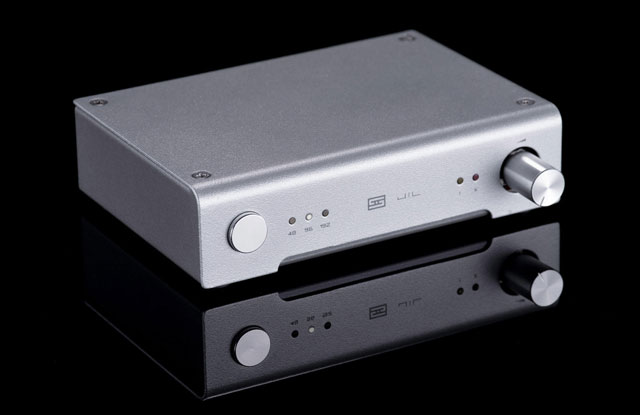
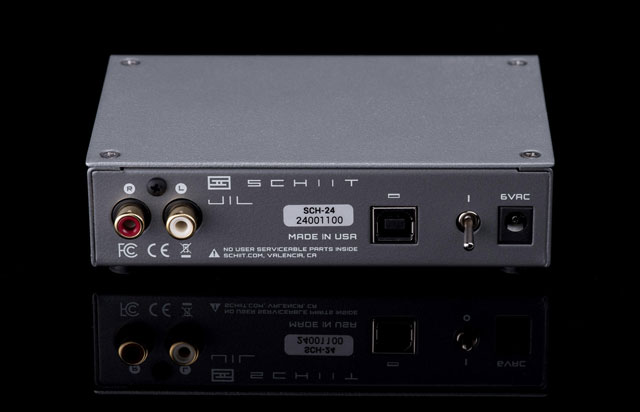
The JIL
The Schiit JIL is simply styled like their other components, in a small, but solid, package. With a pair of unbalanced inputs and a USB out, the JIL rips at 48, 96 and 192kHz, (no multiples of 44.1), and comes with a gain control for adjusting the input volume and two peak level LED lights. The review sample I received has a solid aluminum finished chassis, a power switch, AC input and adapter. The diminutive JIL’s case is approximately 1.25” tall x 3.5” deep x 5” long. I was intrigued that the JIL offers 24 bit rate 192kHz sampling rate ripping, a real plus if done well. Schiit says it offers a 15-day trial period (the equipment must be returned within the 15 days).
Preparing the Files
In comparing the Schiit JIL with the HRT LineStreamer+, I hoped to compare the JIL’s virtues and flaws with those of a comparably priced A2D converter, though the HRT only rips up to 2496. The HRT LS+ seems unavailable anywhere and I don’t know its future nor that of High Resolution Technologies, its maker. Perhaps the LS+ has been discontinue d and they are getting ready to launch a new model… or HRT itself is gone.
Recording on the Mac with the HRT LineStreamer+ is a relative snap. Once an external phono stage is connected to the HRT’s RCA jacks, you the HRT into your computer via USB, select the unit in the Sound Control panel, Audio Midi Setup panel and the prefs in the recording program (in my case, Sound Studio 4). The HRT LS+ handles the input volume. Your resolution is displayed on one end of the LS+.
Recording with the JIL, adds two steps to the above workflow, setting the rip resolution and adjusting the gain control with the JIL’s front-mounted selectors. You must play the loudest passages to set the proper input gain, which added time to my ripping because vinyl shouldn’t be played more than once every 24 hours and I choose to wait until the next day for the vinyl to return to shape before ripping again. The input gain was a bit different with each album and I found it desirable to not max out the gain setting. “Normalizing” the ripped file to -0.10 db of the maximum setting sounded, to my ear, sounded a touch quieter when played back. I read someplace to never normalize at 100% – some audio players don’t like that.
Did I say that upgrading to Sound Studio 4 solved the issue of recording past the v2 2 gb recording limit? Well, using the JIL posed a new limit issue. A 24 bit, 192kHz file of some new vinyl releases may tax the 4gb limit of v4. I found that recording each LP separately (sides 1 and 2 together, etc.) solved that problem.
For comparison purposes here, I recorded a number of whole albums as well as quite a few of the same LP sides at different settings, on different days, of course, so as not to adversely affect the vinyl. I have some high resolution downloads of the same albums to compare to a few of the rips as well.
Listening to the Rips
Liszt’s Todtentanz, from the Classic Records reissue of “ (Liszt) )Todtentanz / (Rachmaninoff) Concerto No. 1 In F-Sharp Minor, Op. 1” by Byron Janis and the Chicago Symphony Orchestra, under the baton of Fritz Reiner (Classic Records, RCA Victor Red Seal, 1994), proved a worthy source for the Schiit JIL. My 2496 rip delivered strong bass, crisp horns that were a touch rounded and a piano image that was convincing, if a touch distant. There was a nice rosin texture to the strings and a good weight to their plucks. All in all, a nice vinyl rip, with just a touch of vinyl artifacts, something I could easily live with.
In comparison, the HRT LS+ rip was a touch louder, making it appear a bit more present. A bit of vinyl drag was evident in the silent areas but not distracting. The HRT produced the same strong bass and sensual and percussive string plucks, but the piano’s image seemed a bit flatter and a bit less recessed. The dynamics with both A2D’s were good, but the Schiit JIL had a bit more depth here.
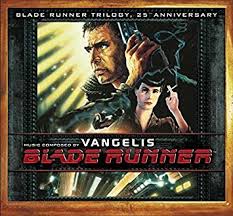 Vangelis’ “Blade Runner” soundtrack, released on red translucent vinyl in 2013 by Audio Fidelity, is always a fun spin. The dynamics rendered are full and pretty amazing and the dialog included mates well with the musical content, allowing for extended run time on a single vinyl disk. The HRT LS+ rip placed Ford’s dialog closer to the front of the stage, the JIL located it farther back, with a bit more depth to the soundstage. Dynamics were great with both HRT and JIL rips and bass was explosive. Crisp but not overly etched chimes and triangles had a nice sparkle and effects provided a more immersive experience for a great 2-channel presentation. The highs were laid back and ever-so rounded in the HRT rip compared to the JIL and other A2D’s offer dynamics with punch, and both included a touch of upper frequency compression due to the extended run time of this single LP pressing.
Vangelis’ “Blade Runner” soundtrack, released on red translucent vinyl in 2013 by Audio Fidelity, is always a fun spin. The dynamics rendered are full and pretty amazing and the dialog included mates well with the musical content, allowing for extended run time on a single vinyl disk. The HRT LS+ rip placed Ford’s dialog closer to the front of the stage, the JIL located it farther back, with a bit more depth to the soundstage. Dynamics were great with both HRT and JIL rips and bass was explosive. Crisp but not overly etched chimes and triangles had a nice sparkle and effects provided a more immersive experience for a great 2-channel presentation. The highs were laid back and ever-so rounded in the HRT rip compared to the JIL and other A2D’s offer dynamics with punch, and both included a touch of upper frequency compression due to the extended run time of this single LP pressing.
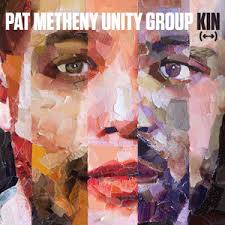 I bought the 2496 download from HD Tracks of the Pat Metheny Unity Group’s “Kin ()” (Nonesuch 2014) over Christmas 2016 at a great price. Playing a 24192 rip from the JIL, there was powerful bass, cymbals were alive and sparkling and the download offered the same, though with perhaps with a bit more gain so as to appear to have more punch – volumes equalized, this difference decreased. A 2496 rip from the JIL offered a stage of good depth and solid imaging. The 2496 download bettered the JIL;s same res rip with snappier and more dimensional drum transients and the low frequencies had a bit more bloom. The download was better, but it wasn’t a cakewalk. With the JIL, these subtitles were better preserved in the 24192 rip. The download and Jill rips were, all in all, quite close in render. I did not expect this.
I bought the 2496 download from HD Tracks of the Pat Metheny Unity Group’s “Kin ()” (Nonesuch 2014) over Christmas 2016 at a great price. Playing a 24192 rip from the JIL, there was powerful bass, cymbals were alive and sparkling and the download offered the same, though with perhaps with a bit more gain so as to appear to have more punch – volumes equalized, this difference decreased. A 2496 rip from the JIL offered a stage of good depth and solid imaging. The 2496 download bettered the JIL;s same res rip with snappier and more dimensional drum transients and the low frequencies had a bit more bloom. The download was better, but it wasn’t a cakewalk. With the JIL, these subtitles were better preserved in the 24192 rip. The download and Jill rips were, all in all, quite close in render. I did not expect this.
What really surprised me was a comparison between 2496 and 24192 rips and the vinyl of Cassandra Wilson’s “Traveling Miles” (Blue Note 1999). Playing the 24192 JIL rip, percussive transients were plentiful and playful, driving the first track “Run the Voodoo Down.” The JIL 24192 rip gave a depth to Wilson’s vocals and the percussion was very well presented, along with solid powerful bass and low frequencies. The vinyl gave the same solid presentation of Wilson voice, along with great drums of nice depth and great skin textures supported by plentiful bass. The HRT LS+ 2496 rip was also pretty faithful to the LP. The JIL’s 24192 presentation was surprisingly closer to the vinyl, with the Schiit JIL delivering a bit more sparkle, vocal sweetness, image resolution and more effervescence to the percussion fills.
The Wrap
A couple hundred clams isn’t much to pay to make your own higher than Redbook resolution rips, not to mention those of the 24192 variety. Buy the Schiit JIL, stop buying downloads of albums you already own and save some cash. The JIL’s 2496 rips sound very good, and 24192 files from the JIL are great sounding. The Schiit JIL is staying in-house.


greg voth
Specifications:
Schiit JIL Analog to Digital Converter
Inputs: RCA stereo (single-ended)
Input Range: 400uV-3.5V RMS
Sample Rates and Bit Depths: 48kHz, 96kHz, 192kHz, 24 bits
Frequency Response: 20Hz-20KHz, +/-0.1dB, 2-100kHz, +/- 3dB
THD:
IMD:
S/N: >110dB, unweighted, referenced to 2V RMS
Crosstalk: -82dB, 20-20kHz
Output: USB 2.0 (compatible with USB 3.0 and 3.1 ports)
ADC: AKM AK5385
USB Output: C-Media CM6631A
Power Supply: Linear, 16VAC wall-wart and low-noise local regulation
Power Consumption: 6W maximum
Size: 5” x 3.5” x 1.25”
Weight: 1 lb
$199 plus shipping (US)
Available Options:
115V USAPplug
230V Australian Plug
230V EuroPlug
230V UK Plug
Website: www.schiit.com/products/jil
The fastest way to get in touch with us for general questions is via email. Just click and ask. Or, if you’re nearby, you can listen to all our gear at The Schiitr, our new retail store.
General questions: info@schiit.com
Questions about your order: orders@schiit.com
Phone: (323) 230-0079 (leave us a message, please . . . we are not psychic. And, if you want timely answers, we strongly encourage email. We do not accept orders via phone. Just email us, OK?)
Visit Schitt and Listen To Schtuff!
The Schiitr
22508 Market Street
Newhall, CA 91321 More Info
Factory Address:
Schiit Audio
24900 Anza Drive, Unit A
Valencia, CA 91355
– – –
Stereo Times Masthead
Publisher/Founder
Clement Perry
Editor
Dave Thomas
Senior Editors
Frank Alles, Mike Girardi, Russell Lichter, Terry London, Moreno Mitchell, Paul Szabady, Bill Wells, Mike Wright, and Stephen Yan,
Current Contributors
David Abramson, Tim Barrall, Dave Allison, Ron Cook, Lewis Dardick, John Hoffman, Dan Secula, Don Shaulis, Greg Simmons, Eric Teh, Greg Voth, Richard Willie, Ed Van Winkle, Rob Dockery, Richard Doron, and Daveed Turek
Site Management Clement Perry
Ad Designer: Martin Perry






Be the first to comment on: Schiit Audio JIL A/D converter